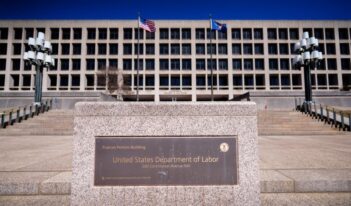
The Department of Labor redefines “spouse” under the Family Medical Leave Act.
Employees in same-sex marriages will soon be entitled to take a leave from work to care for their spouses, regardless of the marriage laws of the state in which they live or work.
Federal law allows workers across the country to take time off from work to address specific family-related issues, like caring for a spouse who is facing a health crisis. Because marriage laws differ by state, it is possible for someone to be considered married under the laws of one state and not another. Workers could gain or lose the family leave benefit just by moving to a different state. With a new rule from the U.S. Department of Labor, employers will instead look to the laws of the place where an employee was married—the “place of celebration”—to determine whether or not the employee is entitled to family leave.
In its 2013 decision in United States v. Windsor, the United States Supreme Court found it unconstitutional for the federal government to define marriage as between one man and one woman, and thereby to withhold federal benefits from same-sex couples who were legally married under state law.
Since that decision nearly two years ago, same-sex couples in many—but not all—states have gained the right to marry. The Supreme Court will soon decide whether a state that does not permit same-sex marriage is required to recognize a same-sex marriage performed in another state. In the meantime, to comply with Windsor, federal agencies have been adjusting national regulations that benefit married couples to ensure that they will also include same-sex married couples.
The Labor Department has recently revised regulations under the Family and Medical Leave Act (FMLA) to change the definition of “spouse” to be more inclusive of same-sex spouses.
The FMLA was passed in 1993, providing eligible employees with up to twelve weeks of leave per year when facing specific family situations, such as caring for family members’ serious health conditions. This federal family leave is available to eligible employees of private employers who have at least fifty employees, employees of elementary schools (both public and private), and employees of public agencies. Employers are not required to pay employees when they are on leave, but must allow employees to continue receiving health benefits throughout the leave and to return to the same or equivalent positions. The FMLA is reportedly well received by employees and is not overly burdensome to their employers.
An employee may be entitled to leave under the FMLA “to care for the spouse, or a son, daughter or parent.” Earlier regulations defined “spouse” by reference to the marriage laws of the state in which an eligible employee resides. Under the old rule, legally-married, same-sex couples who reside in states that do not recognize their marriage would not be entitled to spousal leave under this federal law.
The Labor Department sought to provide uniform rights to federal family leave for all legally married couples, no matter where they live. This new “place of celebration” rule defines “spouse” based on the law of the jurisdiction in which the marriage took place. It also applies to marriages that were entered into abroad. To be eligible for spousal leave, the couple must be legally married according to the laws of the location in which they were married, and at least one state in the United States must consider such a marriage legal.
The new rule will support worker mobility and help employers recruit out-of-state applicants who might otherwise be concerned that FMLA leave would not be available to them in a new state of residence.
The rule change will have an impact in situations where a same-sex marriage provides the familial relationship that would qualify an employee for time off from work under the FMLA. An eligible employee will be able to take leave to care for a same-sex spouse facing a serious health issue. Employees in same-sex marriages will also be able to take FMLA leave to care for a stepchild, and employees with parents in a same-sex marriage can take time off to care for a parent’s spouse.
As of 2012, the Labor Department estimated there are 1.2 million places of employment that must comply with the FMLA. By these same estimates, 72.9 million employees are eligible to take leave. The new rule will expand the number of employees eligible to take leave—but not by much. The Department expects the rule will lead to approximately 8,200 additional occasions of family leave per year.
The Labor Department’s new rule will go into effect on March 27, 2015.



